How Long Do Chickpeas Last in Fridge
Your stored chickpeas will last different lengths of time depending on their type and storage method. Cooked chickpeas stay fresh for 3-5 days in an airtight container in your fridge, while opened canned chickpeas remain good for 3-4 days when properly stored. You'll want to keep them at a consistent temperature between 35-40°F and watch for signs of spoilage like mold, unusual smells, or slimy texture. For best results, store your chickpeas in glass or BPA-free containers with tight-fitting lids, and make sure they're cooled to room temperature before refrigerating. Understanding proper storage techniques can greatly extend your chickpeas' shelf life.
This post may contain affiliate links. If you make a purchase through these links, I may earn a commission at no additional cost to you. Additionally, portions of this post may be generated using artificial intelligence (AI) technology. While we strive for accuracy, please be aware that AI-generated content may not always be perfect and should be fact-checked when necessary.
The Spatula Scoops
- Cooked dried chickpeas stay fresh for 3-5 days when stored in an airtight container in the refrigerator.
- Opened canned chickpeas remain good for 3-4 days when transferred to a proper storage container in the fridge.
- Store chickpeas at a consistent temperature between 35-40°F (1.6-4.4°C) for optimal freshness.
- Check for signs of spoilage like mold, unusual odors, discoloration, or slimy texture before consuming stored chickpeas.
- Use airtight glass or plastic containers and store chickpeas in the main compartment, not the fridge door.
Storage Times for Different Chickpea Types

Chickpeas come in several forms, each with different refrigeration lifespans. You'll find that dried chickpeas, once cooked, will stay fresh in your fridge for 3-5 days when stored in an airtight container. If you're using canned chickpeas, they'll last about the same time after opening, provided you've transferred them to a proper storage container.
For fresh, uncooked chickpeas that you've just removed from their pods, you'll want to use them within 2-3 days for ideal freshness and nutritional value. Homemade chickpea preparations, like hummus or falafel mixture, typically maintain their quality for 4-7 days when properly refrigerated. If you've sprouted your chickpeas, they'll stay fresh for up to 1 week in the fridge, but you'll notice the best texture and flavor within the first 3-4 days.
Remember that these timeframes assume you're storing your chickpeas at a consistent temperature of 40°F (4°C) or below. You'll know your chickpeas have gone bad if you spot any mold growth, detect an off-putting smell, or notice a slimy texture on their surface.
Signs of Spoiled Chickpeas
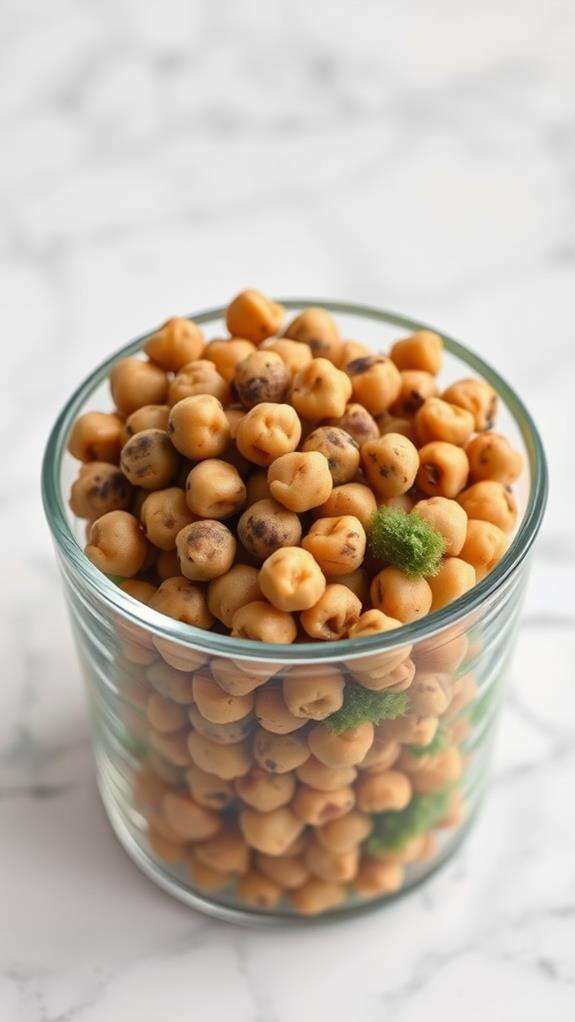
A keen eye and nose are your best tools for identifying spoiled chickpeas. When you're inspecting your stored chickpeas, look for any signs of mold, which typically appears as white, green, or black spots on the surface. You'll also want to check for any unusual discoloration or dark patches that weren't there before.
The smell test is essential – if you notice any sour, fermented, or musty odors, it's time to discard the chickpeas. Fresh chickpeas should have a mild, nutty aroma or almost no smell at all. When examining cooked chickpeas, pay attention to the liquid they're stored in; it should be clear or slightly cloudy, not slimy or excessively thick. If you see bubbles forming or the liquid appears fizzy, that's a clear indication of fermentation.
Texture changes are another red flag. Your chickpeas shouldn't feel slimy or sticky to the touch. For dried chickpeas, watch out for signs of moisture exposure, such as clumping or visible water damage. If you spot any bugs or insect eggs, which appear as tiny white specks, immediately dispose of the entire batch.
Best Storage Container Options
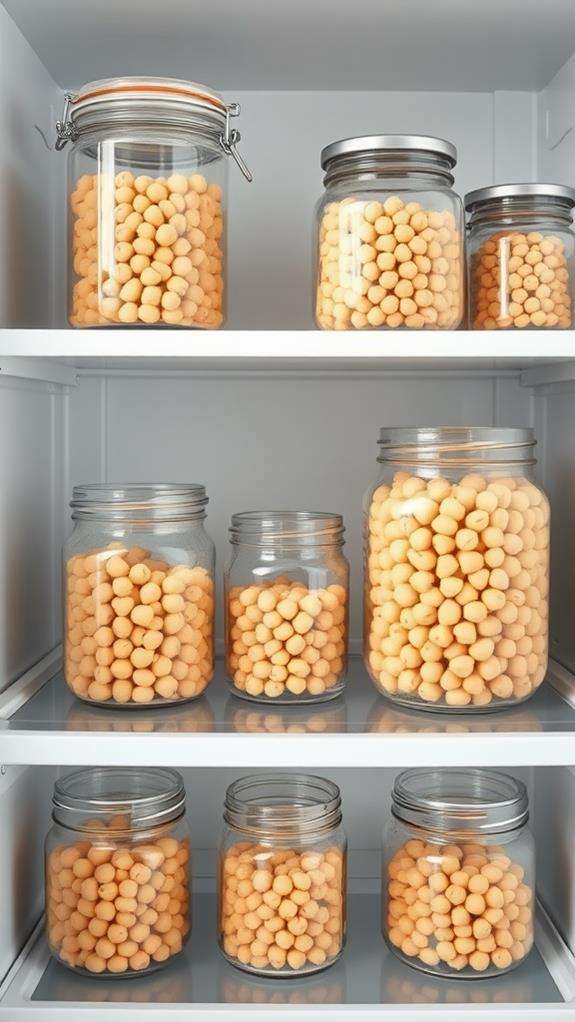
Proper storage containers play a key role in preventing spoilage and maximizing your chickpeas' shelf life. For peak freshness, you'll want to choose airtight containers made from glass, BPA-free plastic, or food-grade stainless steel that can seal completely.
Glass mason jars with secure lids are your best option, as they're non-porous, won't absorb odors, and let you easily monitor your chickpeas' condition. If you're using plastic containers, opt for those with snap-lock lids or gasket seals to prevent air exposure. You'll find that square or rectangular containers utilize your fridge space better than round ones.
When storing cooked chickpeas in their liquid, you'll need containers with enough headspace to accommodate expansion. Don't fill them more than 3/4 full, and verify the lid creates an airtight seal. For meal prep purposes, consider portion-sized containers that hold 1-2 cups each. You can also use resealable freezer bags, but remove as much air as possible before sealing. Whatever container you choose, make certain it's clean, completely dry, and free from cracks or damage that could compromise the seal.
Refrigeration Tips and Guidelines
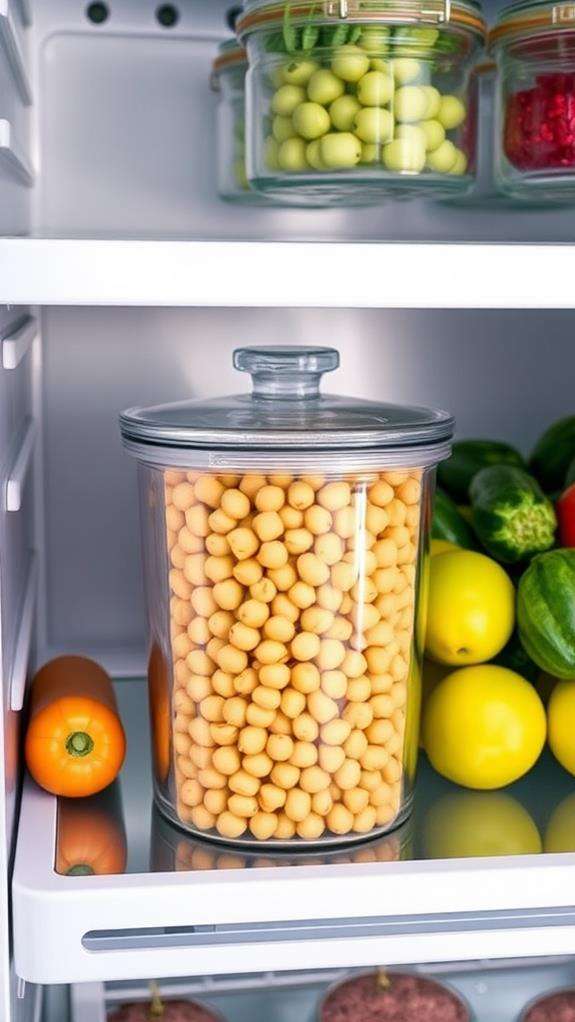
Once you've selected the right container, maintaining ideal refrigeration conditions will help your chickpeas stay fresh longer. You'll want to keep your refrigerator temperature between 35-40°F (1.6-4.4°C), and store your chickpeas in the main compartment rather than the door, where temperatures can fluctuate.
| Storage Condition | Recommended Action | Expected Result |
|---|---|---|
| Temperature | Keep at 35-40°F | Prevents bacterial growth |
| Moisture Level | Pat chickpeas dry | Reduces spoilage risk |
| Container Position | Back of main shelf | Maintains stable temp |
To maximize freshness, you'll need to guarantee your chickpeas are completely cool before refrigerating them. If you're storing home-cooked chickpeas, let them reach room temperature first, but don't leave them out for more than two hours. Remember to check your refrigerator's humidity settings, as excess moisture can lead to premature spoilage. If you notice any condensation forming inside your storage container, briefly open it to release excess moisture and wipe the lid dry. Position the container away from strong-smelling foods, as chickpeas can absorb other odors easily.
Extending Chickpea Shelf Life
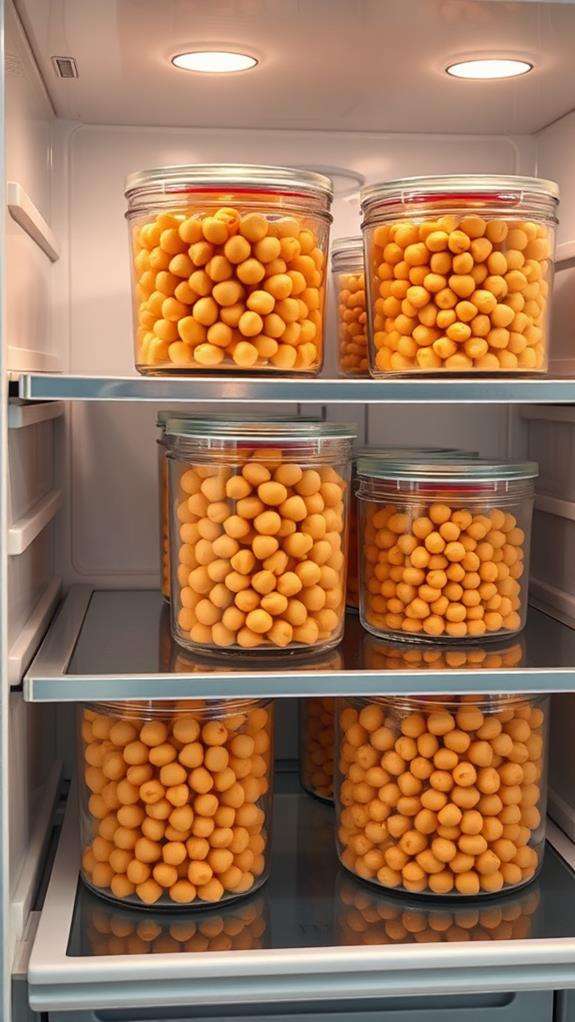
While following proper refrigeration guidelines is important, several additional strategies can greatly extend your chickpeas' shelf life. You'll want to store them in an airtight container, preferably glass or BPA-free plastic, and confirm they're completely dry before storage. If you're storing cooked chickpeas, remove them from their cooking liquid and pat them dry with a clean paper towel.
To maximize preservation, you can add a few drops of lemon juice to your stored chickpeas, as the citric acid helps prevent bacterial growth. Don't fill the storage container to the brim; instead, leave about half an inch of headspace to prevent moisture buildup. If you're planning to store them for more than three days, consider dividing them into smaller portions that you'll actually use.
You can also extend shelf life by blanching your chickpeas before refrigeration. Simply dip them in boiling water for two minutes, then immediately transfer them to an ice bath. This process deactivates enzymes that cause spoilage. Remember to check your stored chickpeas daily for any signs of mold, off-putting odors, or slimy texture.
Storing Cooked Vs Canned Chickpeas
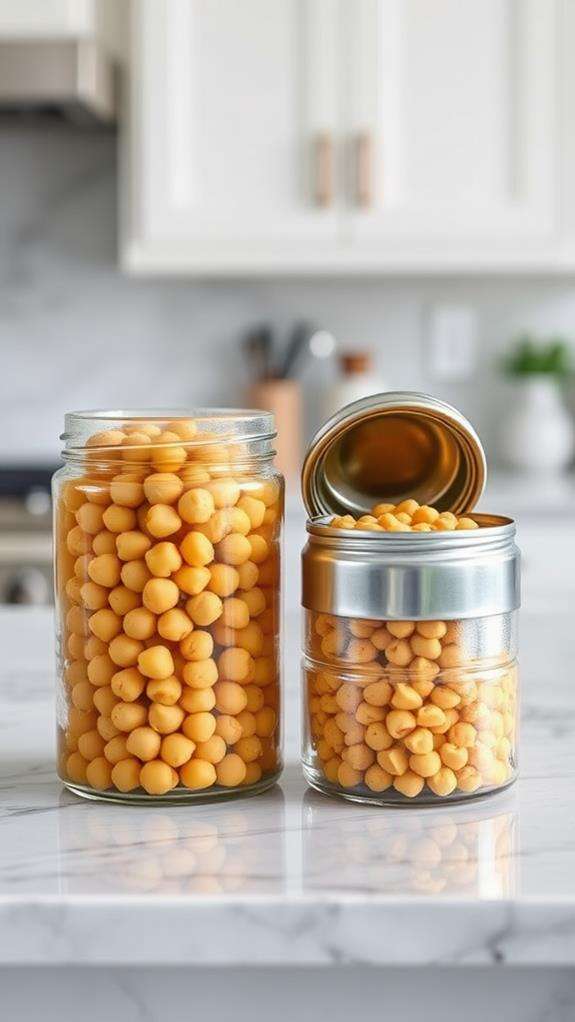
Storage methods differ greatly between cooked and canned chickpeas, with each type requiring specific handling for ideal preservation. When you're storing cooked chickpeas, you'll need to place them in an airtight container and refrigerate them within two hours of cooking. They'll last 3-5 days in the fridge, but you'll want to check for any off-putting odors or signs of mold before using them.
Canned chickpeas, on the other hand, follow different storage rules once opened. You can't keep them in their original can after opening – you'll need to transfer them to an airtight container. Once you've done this, they'll stay fresh in your fridge for 3-4 days. If you haven't opened the can yet, you can store it at room temperature in your pantry for 2-5 years, depending on the expiration date. For both types, you'll want to verify they're stored at a consistent temperature of 40°F (4°C) or below in the fridge. You can also extend their shelf life by freezing them – both cooked and canned chickpeas freeze well for up to 6 months.
Temperature and Moisture Control
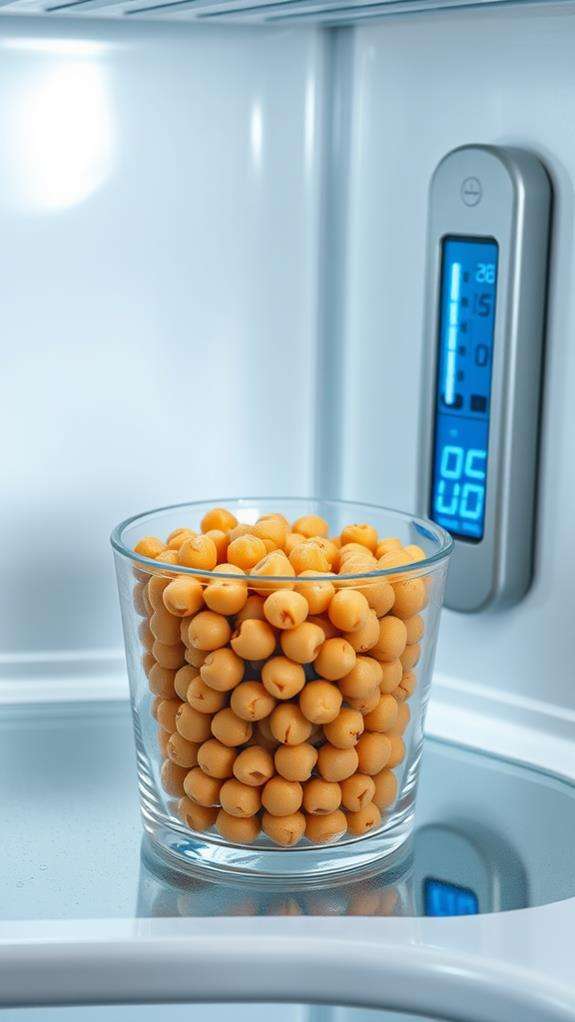
For ideal chickpea storage in your fridge, you'll want to maintain a consistent temperature between 37-40°F (3-4°C), which helps prevent bacterial growth while preserving texture and flavor. You should aim to keep the humidity level around 40-50% in your refrigerator, as excess moisture can lead to premature spoilage and mold growth in stored chickpeas. To control unwanted moisture, store your chickpeas in an airtight container with a paper towel at the bottom to absorb any condensation, and always make sure they're thoroughly drained before refrigerating.
Ideal Storage Temperature Range
Maintaining ideal temperature control is vital for extending the life of chickpeas in your refrigerator. You'll want to keep your stored chickpeas at a consistent temperature between 37°F and 40°F (2.8°C to 4.4°C), which is the best range for most refrigerated foods. This temperature zone effectively slows bacterial growth while preserving the chickpeas' texture and nutritional value.
- Set your refrigerator's main compartment to 38°F (3.3°C) for the best balance between food preservation and energy efficiency
- Avoid storing chickpeas in the door compartments, where temperatures can fluctuate due to frequent opening
- Use a refrigerator thermometer to monitor the temperature consistently, as built-in displays aren't always accurate
- Keep chickpeas away from the back wall of the refrigerator, where items might freeze if they make contact
When you're storing your chickpeas, it's important to understand that temperature stability matters as much as the actual temperature reading. Frequent temperature fluctuations can lead to condensation, which creates an environment where bacteria thrive. You'll get the best results by keeping your chickpeas in an airtight container on a middle shelf, where temperature remains most constant.
Humidity Level Requirements
Proper humidity control plays a crucial role in preserving chickpeas' quality during refrigeration. You'll want to maintain relative humidity levels between 50-60% in your refrigerator to prevent excess moisture from promoting bacterial growth while avoiding excessive dryness that can make your chickpeas hard and unpalatable.
To achieve the best humidity levels, you'll need to store your chickpeas in an airtight container with a secure lid. If you're storing cooked chickpeas in liquid, make sure they're completely submerged to prevent the top layer from drying out. For dried chickpeas, you'll want to keep them in a container with minimal air space to reduce moisture exposure. Don't store them in the crisper drawer, where humidity levels are typically higher and designed for produce.
You can monitor your fridge's humidity using an inexpensive hygrometer, which you'll find particularly useful if you're storing multiple types of legumes. If you notice condensation forming inside your storage container, that's a sign your humidity levels are too high. In this case, you should transfer the chickpeas to a new container with a moisture-absorbing paper towel at the bottom.
Control Excess Moisture
A towel-lined container offers your first defense against excess moisture when storing chickpeas in the fridge. You'll want to pat your chickpeas dry before storage and make sure they're not dripping wet, as excess water can lead to premature spoilage and potential mold growth.
To effectively control moisture levels while storing your chickpeas, consider these essential steps:
- Line your storage container with paper towels or a clean kitchen cloth to absorb any residual moisture
- Replace the moisture-absorbing liner every 2-3 days, especially if you notice dampness
- Keep the container's lid slightly loose to allow minimal air circulation without drying out the chickpeas
- Place your container on a middle shelf in the fridge, away from the cooling elements where condensation tends to form
You'll know you're managing moisture correctly when your chickpeas maintain their firm texture without becoming slimy or developing an off-putting odor. If you're storing larger quantities, consider dividing them into smaller portions with separate moisture control measures for each container. This approach helps prevent moisture buildup and makes it easier to monitor the condition of your stored chickpeas.
Safe Handling Practices
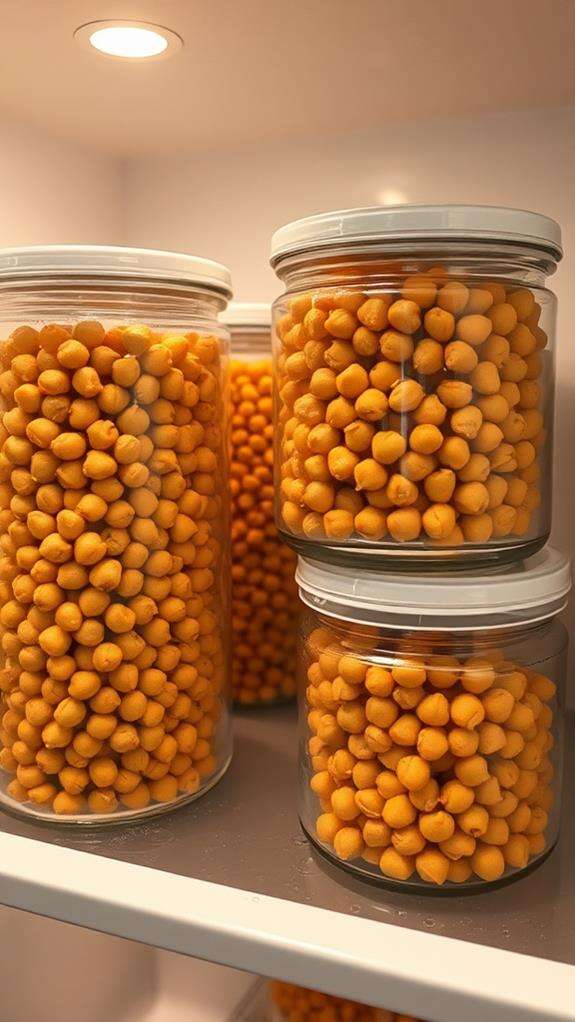
Safe storage of chickpeas begins with clean hands and utensils when handling these protein-rich legumes. Before you touch your chickpeas, wash your hands thoroughly with soap and warm water for at least 20 seconds, and guarantee all your storage containers are properly sanitized.
When you're transferring chickpeas, use clean utensils or tongs rather than your hands to minimize bacterial contamination. You'll want to avoid cross-contamination by keeping raw ingredients separate from your cooked chickpeas, and don't reuse containers that have held raw ingredients without washing them first. If you're using canned chickpeas, remember to rinse the strainer before and after use.
Always check the temperature of your refrigerator, maintaining it at or below 40°F (4°C) to prevent bacterial growth. When you're storing cooked chickpeas, let them cool completely before refrigerating, but don't leave them at room temperature for more than two hours. Transfer them to an airtight container using a clean spoon or ladle, and be certain you're not mixing old and new batches of chickpeas together, as this can affect their overall shelf life.
Frequently Asked Questions
Can Frozen Chickpeas Be Refrozen After Thawing?
You shouldn't refreeze thawed chickpeas as this can considerably impact their texture and food safety. When you freeze, thaw, and refreeze food, ice crystals form repeatedly, breaking down the chickpeas' cellular structure. This process makes them mushy and increases the risk of bacterial growth. Instead, you'll want to thaw only the amount you plan to use. If you've already thawed too many, store them in the fridge and use them within 2-3 days.
Do Chickpeas Continue to Soften in the Refrigerator Over Time?
Like tiny time travelers in your fridge, chickpeas do continue their journey of softening even after cooking. You'll notice they'll gradually become mushier over time, as the starches in the legumes continue to break down. This process happens whether they're home-cooked or canned, but it's slower in cold temperatures. That's why you'll want to eat your refrigerated chickpeas within 3-5 days for the best texture and taste.
Should Chickpeas Be Rinsed Before Each Use From the Fridge?
Yes, you should rinse stored chickpeas before each use, as it helps remove any surface bacteria, slime, or off-flavors that may have developed during storage. If you've stored them in their original liquid, you'll want to drain and rinse them to improve their taste and texture. For canned chickpeas that you've transferred to the fridge, a quick rinse will also help remove excess sodium and starch, making them more digestible and better-tasting.
Can You Store Chickpeas and Their Cooking Liquid Together?
While you're in a pickle deciding about storage, you can keep chickpeas in their cooking liquid. It's actually beneficial, as the liquid helps preserve the chickpeas' texture and prevents them from drying out. You'll want to store them in an airtight container, and the liquid should completely cover the chickpeas. Just remember that homemade cooking liquid lasts about 3-5 days, while canned liquid can stay good for up to a week.
Will Chickpeas Change Color Naturally During Refrigerator Storage?
Yes, your chickpeas can naturally change color during refrigerator storage. You'll notice they might develop a slightly darker or duller appearance after a few days, though they're still safe to eat. This color change happens due to oxidation and exposure to light, similar to how an apple browns when cut. If you see any pink, brown, or green spots developing, that's a different story – it's likely mold, and you'll need to discard them.





